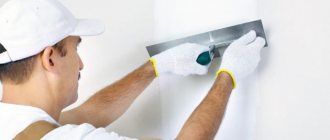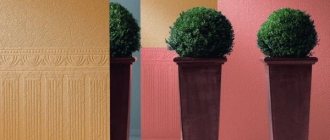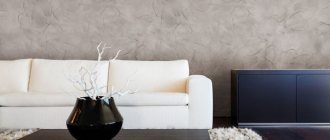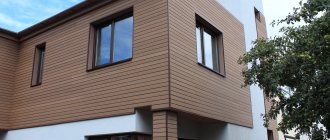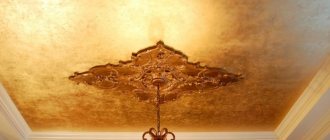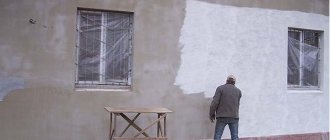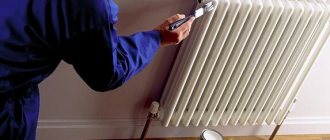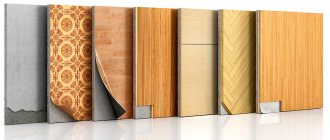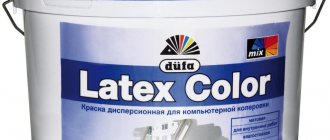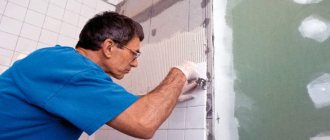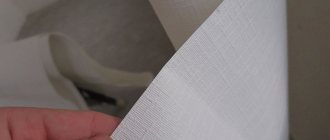Gypsum-based building materials are widely used by owners for comfortable furnishing of apartments. Gypsum fiber sheets (GVL) and plasterboard (GKL) are popular solutions that are used in construction and repair. We invite you to conduct a comparative analysis of these materials, which will allow you to understand the difference between them and determine whose set of properties - gypsum fiber board or gypsum plasterboard - is more preferable.
Drywall
GKL - plasterboard sheets - do not need unnecessary popularization. This is a material that is one of the most in demand in repair and construction work. Its structure is:
- Gypsum layer (93%).
- Cardboard layer (6%).
- Organic (1%).
To create a gypsum board, a layer of cardboard is glued onto the gypsum layer; it also contains small amounts of organic substances and humectants. The result is a durable material with a smooth surface, which is given to it by cardboard. Taken together, these properties make it possible to effectively use gypsum boards for various construction and repair needs.
Which is better: gypsum fiber board and plasterboard on the walls
The market for construction and finishing materials has been developing at a particularly rapid pace in recent years.
Today, such a wide assortment is presented to the attention of potential buyers, it is not easy even for professional builders to understand this ocean of offers. In this article I would like to take a closer look at what is the difference between plasterboard and gypsum fiber sheet - two universal materials intended for interior decoration, and what is better for finishing premises - gypsum fiber board or gypsum board?
To answer this question, we will conduct a comparative analysis of these two materials made on the basis of gypsum.
Characteristic features of drywall
Drywall has the following characteristics:
- the ability to absorb moisture when there is excess and release when there is a deficiency;
- high sound insulation properties;
- decent fire resistance (characteristic only for sheets marked GKLO);
- safety from an environmental point of view;
- the ability to create curved shapes;
- moisture-resistant plasterboard (GKLV) is successfully used in wet rooms.
The cost of one square meter of plasterboard is about 150 rubles, which is 2–2.5 times less than the cost of gypsum fiber. The difference in price between these materials is one of the most significant for many.
Main characteristics of moisture-resistant gypsum fiber sheet (gvlv)
The very concept of “plasterboard” is quite broad, since it includes several types of this material. They differ significantly in operating conditions, and, accordingly, in their composition. In addition, there is such a thing as a “fiber supersheet”. Such material has a number of advantages compared to gypsum board and, according to the Knauf classification, is divided into:
- superlist (gvl),
- moisture-resistant supersheet (gvlv),
- small format supersheet.
Each of the above options is characterized by increased mechanical strength, excellent sound insulation, fire resistance and has a special fibrous structure. The latter property allows you to carefully cut drywall and process edges without much effort.
Technical characteristics of gvl (gvlv)
Gypsum plasterboard supersheet has special properties that allow it to be used not only for covering walls, ceilings, but also for floors! Thanks to a high-quality mixture of fiber and gypsum, as well as a special anti-chalking impregnation, supersheet can be used in buildings and premises for any purpose. The only fundamental difference in the use of gypsum board and moisture-resistant gypsum board is the possibility of installing the latter in places with high humidity. All main parameters of the sheets are given in Table 1.
Table 1. Characteristics of gvl supersheet (gvlv)
The moisture-resistant material differs from standard gypsum plasterboard in that its surface on both sides is treated with a special water-repellent agent. This allows it to be used in rooms with any degree of humidity.
If we talk about the properties of the materials, they are very similar. The dimensions and weight of moisture-resistant gypsum board are the same as those of a standard super sheet. The following characteristics are also identical: humidity, Brinell hardness, flexural strength and thermal conductivity gvl and gvlv. At the same time, the range of applications for moisture-resistant drywall is wider than standard, since even in the bathroom it will “stand idle” for its entire service life.
Advantages and application of moisture-resistant supersheet
Fibrous gypsum board has all the advantages of conventional drywall:
- environmental friendliness,
- high heat and sound insulation,
- non-flammability,
- mechanical strength and abrasion resistance,
- ease of installation.
It has only two drawbacks: price and significant weight of the gvl (gvlv) sheet. The first problem can be solved by minimizing waste, and the second can be solved by using a good assistant during the installation process.
Moisture-resistant plasterboard can be used in almost any type of building. Main use cases:
- in places with a high fire hazard as wall and ceiling cladding,
- for cladding attics, balconies and basements (if ventilation is available),
- for the construction of partitions in apartments with high humidity (for example, in bathrooms),
- for unheated rooms,
- for prefabricated floor subfloors.
In the bathroom, it is recommended to additionally treat the surface of the wall made of glvv from Knauf with special moisture-resistant decorative coatings (paint) or cover it with ceramic tiles.
Relevance of using gypsum boards
The material is used to create partitions, various structures, and wall cladding. GCR is easy to install, so you can implement various ideas in terms of interior design, achieve cosmetic cleanliness in your living space, and also implement original construction and finishing ideas even on your own.
USEFUL INFORMATION: What you can make from plasterboard with your own hands: a dressing room made of plasterboard in the bedroom
Thanks to sheets of drywall, owners can easily:
- eliminate uneven surfaces in the apartment, hide corners or curved walls;
- make a redevelopment by installing partitions;
- create exquisite design structures in the form of arches, niches, columns;
- complement the room with built-in lighting.
Gypsum fiber: features and scope of application
A material that, due to its properties, has managed to compete with gypsum plasterboard. Gypsum fiber is characterized by high strength and weight, and is not subject to stretching or deformation. GCR and GVL have a similar composition, but the gypsum fiber sheet, consisting of cellulose fibers and pressed gypsum, is homogeneous in structure. The surface of the gypsum plasterboard is polished and impregnated with special compounds that prevent gypsum dusting and moisture absorption.
Just like drywall, gypsum board is used for finishing walls and erecting interior partitions. The moisture-resistant type of gypsum fiber is suitable for use in wet areas such as the bathroom.
A unique feature of gypsum fiber that distinguishes it from plasterboard is the ability to use it for dry floor screed. Special sheets with a straight longitudinal edge are produced for these purposes.
Gypsum fiber: how it differs from plasterboard
There are not so many main differences between plasterboard and gypsum fiber, or rather, only one. If plasterboard is made from pure gypsum, which is placed inside a cardboard shell, then in gypsum fiber boards, during production, cellulose fibers are added to the gypsum solution, which determine all the characteristics of this material.
The gypsum fiber board does not fit inside the cardboard shell. In fact, this combination of natural and artificial materials made it possible to create slabs that can be classified as both plasterboard and chipboard - something in between, combining all the advantages of both materials.
What to choose: gypsum fiber or drywall
Now about the properties and advantages that will allow you to decide what to choose: hypofibre or plasterboard. The advantages of this material include the following.
- High strength. If a sheet of plasterboard can be easily broken or even punched by hand, then with gypsum fiber such a number will not work. Cellulose fibers make these sheets so strong that they can even withstand the load of bulky and heavy furniture. Yes, yes, you heard right - one of the areas of application of gypsum fiber boards is the installation of floors using the dry method. This technology is also called dry screed - this is where gypsum fiber is used for the floor.
- Increased resistance to moisture. There are two types of gypsum fiber boards - regular and moisture resistant. If we compare moisture-resistant drywall with a similar gypsum fiber board, the latter is more resistant to moisture. It can remain in water for a long time and not swell - gypsum fiber in the bathroom can be called an ideal option for leveling walls, ceilings and even floors.
- Less susceptible to deformation than drywall. This point can be attributed to both advantages and disadvantages. On the one hand, this is good (the material is practically not subject to mechanical and other influences), but on the other hand, it is bad (gypsum fiber is not very suitable for making figured ceilings).
- A high degree of heat and sound insulation, which is achieved thanks to the same cellulose. If you use gypsum fiber to create interior partitions, then you can safely refuse the insulation that is placed in the cavity between the sheets.
- High fire safety. As you know, plasterboard belongs to the flammability group B2, and gypsum fiber to group B1 - it is practically not subject to combustion due to the absence of a cardboard shell.
If we talk about the disadvantages of this material, we can note several: firstly, it is higher in cost than plasterboard; and, secondly, the need for mandatory surface treatment with putty. In contrast, drywall only requires sealing the seams and screw heads.
Advantages and disadvantages of gypsum fiber
Distinctive properties
The material is characterized by a number of features:
- environmental safety, contains no formaldehyde and resins;
- moisture resistance (refers to GVLV) and increased fire resistance;
- excellent heat and sound insulation properties;
- frost resistance;
- high density.
One square meter of gypsum fiber sheet costs 300–400 rubles.
Comparison of GVL with analogues
First, let's figure out what GVL is. It differs from standard drywall mainly in its manufacturing technology. If the sandwich principle is used in the production of plasterboard (that is, two layers of cardboard and a gypsum layer between them), then in the case of gypsum board, manufactured fibers are mixed into the gypsum mixture and pressed into the form of a sheet. This results in increased strength and excellent fire performance. An analogue of GVL SML is a fairly new finishing material made in China. The glass-magnesium sheet contains in its structure magnesium oxide, finely dispersed shavings, perlite, magnesium chloride and binder composite materials. One of its good qualities is its non-flammability. In this regard, none of the currently known materials can compare with LSU. GVL is also inferior to it in fire resistance.
It is impossible not to note the moisture resistance. LSU perfectly withstands high humidity conditions. Test results have proven that even after immersion in water for several hours, the LSU does not lose its shape. It is also not susceptible to mold, deformation, does not contain harmful substances, flexible, durable, lightweight and quite easy to use. But in our country this material has not yet been studied enough, so not everyone risks getting involved with it, preferring GVL or GCR. GCR is the most common option. This is a composite finishing material that is traditionally used for finishing residential and office premises. Drywall is environmentally friendly and does not contain any harmful impurities. Excellent soundproofing characteristics and non-flammability make it the most common and versatile material for constructing interior partitions, leveling walls and installing ceilings. property is interesting
when the humidity in the room is high: the material absorbs excess moisture, and when the air is dry, it releases it. GVL is, in fact, an improved version of gypsum plasterboard, superior to it in some respects. For example, increased strength and fire resistance. In general, GVL has a huge list of advantages:
- Excellent heat and sound insulation.
- Environmental friendliness and safety.
- Increased strength.
- Easy to use.
- Low amount of waste during installation.
- Possibility of mounting on both wooden and metal frames.
- Another quality that can be noted is the ease of processing of joints.
- It is not necessary to use special tools to cut gypsum fiber board.
The list of shortcomings is not so impressive. It is limited by a large mass that prevents deformation and stretching. You won't be able to bend it like drywall. And the second drawback is the high cost compared to the same drywall.
Strength
Which is better, gypsum plasterboard or gypsum plasterboard, if you look at the strength of materials? Gypsum fiber is preferable for rooms with higher requirements regarding impact protection. How important this is in relation to apartments is up to the owners to decide.
Drywall is easier to break through, its cardboard shell can be damaged, and it can “go limp” from moisture. Gypsum fiber is much stronger, you can hammer nails into it, it will not crumble.
USEFUL INFORMATION: Types and sizes of rollers for painting work
Advantages and disadvantages
The choice is always easier if you know the strengths and weaknesses of competing materials. This allows you to avoid unpleasant surprises, both during operation and during operation.
GKL
Many years of experience in using gypsum board have formed a complete list of the advantages of the material, where nothing is superfluous, nothing is missing:
- affordable price for mass buyers. This plus is one of the most important for families on a limited budget. At the same time, the quality of work and durability do not suffer;
- low thermal conductivity coefficient - 0.30-0.34 W/ (m×K). According to this indicator, the material is comparable to wood. In combination with insulation, an excellent thermal insulation layer is obtained;
- Easy to install: no experience required. The main thing is to know the principles of working with the material, which can be easily found on the World Wide Web;
- flexibility. Many will be surprised. After all, the material easily crumbles upon impacts or strong bends. On the one hand, this is true. On the other hand, with the help of gypsum plasterboard you can make any semicircular arches and complex installations (as evidenced by the photo below);
Methods for bending gypsum boards.
- fire resistance. The gypsum itself does not burn, but only melts at +1450°C. Only cardboard can burn. But after it is treated with fire retardants, it becomes difficult to burn (painted pink);
- moisture resistance. In fact, gypsum absorbs moisture very well. However, processing sheets with special compounds makes it possible to use the material in rooms with high humidity (kitchen, bathroom);
- high level of maintainability - dents, cracks, and through holes can be easily repaired. As a last resort, the damaged area is replaced;
- versatility. Can be mounted in any room (residential, non-residential) under any finish (wallpaper, paint, ceramic tiles);
- environmental cleanliness. The material contains no additives harmful to health;
- the ability to easily and simply hide communications. But the main thing here is not to overdo it and arrange inspection hatches at the points of connections or adjustments.
The list of advantages of drywall is impressive, but the disadvantages :
- fragility is the main problem of gypsum boards. Sheets may crack during handling (carry only vertically), transportation, or installation. Therefore, special care is needed when working with slabs;
- low strength under weight loads - you can’t hang anything heavy on gypsum plasterboard partitions. It is necessary to provide embedded OSB or plywood boards at the fastening points in advance. You can also use molly dowels. But their weight is limited - for a slab with a thickness of 12.5 mm, such a mount can withstand from 16 to 25 kg of load. This way you can hang a cornice and a TV, but there are no kitchen cabinets or shelves;
- low level of sound insulation, which is important for partitions - even a whisper is perfectly audible. Exit in mineral wool insulation (not polystyrene foam) between sheets of plasterboard.
Another drawback, although common to the materials being compared, is the reduction in space. This is especially noticeable in small rooms or apartments (houses) with low ceilings.
Important: some experts consider the impossibility of covering walls in dachas with gypsum sheets to be a disadvantage—in winter, due to the lack of heating, it will tear. It's hard to agree with this. Firstly, gypsum board is afraid not of frost, but of high humidity (frost tears away sheets that have accumulated moisture). Secondly, you can use moisture-resistant modifications of drywall (GKLV). Thirdly, indoor humidity is lower in winter than in summer. Therefore, after a wet autumn, you can dry the room well and close it for the winter.
GVL
GVL also has its advantages
- high strength allows you to hang heavy objects on vertical structures (a simple self-tapping screw holds up to 30 kg of load), and on the floor to use it as a base under linoleum, parquet, laminate or tiles;
- the presence of viscosity, firstly, allows you to cut the material without dust - it does not crumble, and secondly, you can tighten the fasteners without dowels - it will hold like in wood;
- low heat transfer coefficient, which allows the material to be used as insulation;
- good level of sound insulation - perfectly absorbs air and shock sound waves. This is confirmed by measurements: the noise level drops by 35-40 dB;
- fire resistance - does not burn, but only chars. Therefore it is used as protection for wooden structures;
- the moisture resistance of sheets treated with special compounds (GVLV) is the same as that of cement-sand mortar;
- high frost resistance makes it possible to use it in the country and in unheated rooms;
- hygroscopicity allows, like wood, to regulate the humidity in the room. When the amount of vaporous moisture increases, it is absorbed by the GVL, and when it decreases, it is easily released;
- can be used in a “warm floor” system, but only from below;
- the material is safe in all respects - when heated, it does not emit harmful substances and does not contain allergens;
- there are no restrictions on use: private houses, apartments, cottages, unheated rooms, horizontal and vertical surfaces;
- easy to install - the work can be performed by a home craftsman without the help of specialists;
- not subject to deformation (change in linear dimensions) under the influence of temperature and humidity fluctuations.
There are also disadvantages that you need to pay attention to:
- the price is prohibitive for some segments of the population;
- high specific gravity, as a result of which an assistant is needed during installation. Even though they are smaller in size than drywall, the sheets are much heavier;
- moisture-resistant gypsum fiber sheets can be affected by rot in places with constant high humidity;
- does not bend - can only be used on flat surfaces.
Ease of operation
It is easier to work with homogeneous gypsum fiber sheets in terms of ease of cutting: the material does not crumble, so it can be cut even into very small pieces. However, due to its large mass, the sheet should not be mounted on the wall alone: it can break under its own weight.
Drywall is less durable, so they usually cut it crosswise or try to use whole sheets. But it weighs less, which is important for convenient work. A distinctive feature of gypsum board is also its ability to become plastic when soaked and restore normal strength after drying.
What is the main difference
Despite the gypsum base, the materials have many differences:
- drywall is a three-layer sandwich made of paper and gypsum, GVL is a single piece of hardened gypsum mortar;
- The strength of gypsum fiber is many times higher. You can hang kitchen cabinets on it, which is excluded with gypsum board;
- GVL is less natural - it contains magnesium oxide and magnesium chloride. But these components of the composition are harmless;
- drywall has a much smaller scope of application;
- When cut with a knife, gypsum plasterboard crumbles and becomes dusty when working with a grinder; gypsum board is cut without residue;
- breaks differently when cut: drywall down, gypsum fiber upward. A small thing, but important. If you don’t follow the technology, you won’t get smooth edges;
- It is difficult to work alone with GVL due to its heavy weight. Need an assistant;
- The drywall is puttied before wallpapering. For GVL, such an operation is unnecessary. Here only the joints and heads of hardware are sealed;
- gypsum fiber sheets are more difficult to bend. Therefore, they are difficult to use for curved surfaces;
- Heavy gypsum fiber boards must be mounted on a more durable sheathing. Therefore, it is necessary to use a metal profile with a thickness of at least 0.5 mm.
Moisture resistance
Both gypsum plasterboard and plasterboard can be moisture resistant, but experienced craftsmen say that it is undesirable to use plasterboard in the bathroom even in this version. Gypsum fiber tolerates wet conditions better, however, it must also be protected from direct contact with water with a primer and finish.
It is impossible to give an unambiguous answer to the question of what to choose – gypsum fiber board or plasterboard sheets for walls. One can only note, based on the properties of each of them, that in order to create decorative elements or light structures, it is preferable to use gypsum boards. This is a good choice, because this material is lightweight and affordable, and it can be bent. GVL is appropriate to use in damp rooms; it is also suitable for creating reliable and strong walls, but the price of gypsum fiber is higher.
GVL for the furnace. Performance
As a rule, when choosing a material, the buyer is not interested in “dry” numbers, but in the advantages and disadvantages of the product. Therefore, we will further familiarize ourselves with the performance qualities of GVL.
On the forums, many people ask experts whether the gypsum fiber board actually burns or not? Despite the assurances of the manufacturers, the fire resistance of this material can be discussed with some reservations.
GVL does not ignite
According to GOST 30244-94, the material is classified as G1, i.e. is slightly flammable. According to GOST 30402-96, it belongs to flammability class B1 - does not ignite. But how does this happen in practice?
When exposed to open fire, the surface of the material chars, but does not catch fire. Moreover, when exposed to high temperatures, the crystals contained in the structure of the gypsum fiber disintegrate. This releases water, which resists the flame.
As a result, the fire resistance of gypsum fiber board in minutes, as tests show, averages 90 minutes or more. Those. This is how long the material resists the spread of fire on the surface located behind it. This allows the use of gypsum fiber for fire protection of wooden and other combustible structures.
The fire resistance limit of GVL depends on its thickness. The thicker the material, the correspondingly higher the fire resistance limit.
Gypsum fiber sheets are securely fixed with self-tapping screws
So, whether gypsum fiber burns or not - we figured it out, now let’s get acquainted with other important qualities of the material:
- high density, which is comparable to the density of expanded clay concrete. This allows you to screw self-tapping screws into the gypsum fiber without dowels and even drive nails into it;
- the material does not crumble. Thanks to this, gypsum fiber sheets can be processed with the same tools as wood;
GVL can be used as a flooring material
high strength (twice as much as plasterboard) - this allows the material to be used not only for finishing walls or ceilings, but also for floors. In particular, GVL sheets are often used in the construction of so-called dry screed.
In addition, they can withstand high mechanical loads. Thanks to this, quite heavy pieces of furniture, for example, shelves, can be attached to the sheets;
GVL is able to withstand large mechanical loads
- the low coefficient of thermal conductivity allows you to insulate the room to some extent. The sheets always remain warm to the touch;
- frost resistance - this quality allows the material to be used for finishing unheated rooms. In particular, it can be used in country houses, on balconies, in vestibules, etc.;
- high hygroscopicity - this property allows you to regulate the level of humidity in the room. Those. At high humidity, the material absorbs moisture, and at low humidity, on the contrary, it releases it.
GVL can be used for finishing vestibules and balconies
Of course, along with the advantages, GVL also has some disadvantages:
- the weight is higher than that of gypsum boards, which somewhat complicates transportation and work with the material;
- As a result of its high density, gypsum fiber board is not able to deform. In other words, the sheets do not bend. Therefore, it is more difficult to finish radius surfaces with them;
- the material is more fragile than drywall, so you need to work with it carefully. This is especially true for the thinnest sheets.
In addition, the price of gypsum board is slightly higher than that of drywall. You can verify this from the following table:
In order for gypsum fiber sheets to last a long time, they cannot be coated with silicate paints and putties, as well as compositions based on liquid glass.
Thus, gypsum fiber sheets are a good alternative to plasterboard, especially in cases where high strength or fire resistance is required from the material.
